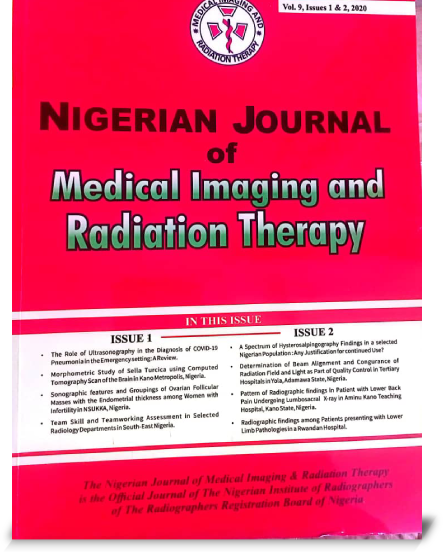CARINAL ANGLE MEASUREMENT IN RESOURCE-CONSTRAINED SETTINGS USING SIMPLE POSTEROANTERIOR CHEST RADIOGRAPH
Mohammed Abba1, Zaharaddeen Usman1, M.Y. Dambele1, Abdu Hamisu Dambatta2, Nwokorie Emmaneul3, Yusuf S. Aliyu4 , Abdulfatai K. Bakre5
Abstract
Background: The carina is a ridge of cartilage in the trachea that occurs between the division of the two main bronchi. Determining the sub-carinal angle is of clinical importance as it serves as a guide in the diagnosis of some thoracic pathologies mostly related to the heart. However, advances in imaging modalities have made computed tomography more popular. Unfortunately, its cost and relative non-availability, still make planar radiography relevant especially in resource-limited communities.
Objectives: Todeterminethesub-carinalangleinthepopulationandtoassess if differences exist based on gender. To assess the relationship of Sub-carinal angle with age and height
Methodology: The sub-carinal angle (SCA) was measured on normally reported, high-quality plain PA-chest radiographs of 90 normal adults within the age range of 18-70 years (37 males and 53 females) that attended the Conventional Radiography Unit of the Radiology Department at Aminu Kano Teaching Hospital, Kano (AKTH) from July to August 2018.
Results: Overall mean ± SD sub-carinal angle was estimated at 58.31o ±10.57o. There was a statistically significant gender difference in SCA (p=0.01). A statistically significant difference also exists between the Left Sub Bronchial Angle (LSBA) among genders (p=0.01) only. A weak correlation exists between SCA with age. Height does not correlate with SCA (r= -0.14, p= 0.16).
Conclusion: Sub-carinal angle differs with gender. Age affects the SCA in some respects. Height reduces the angle although insignificant. Relevant health workers working in remote rural areas with limited diagnostic facilities now have a simple and cost-effective means of diagnosing mediastinal pathologies



